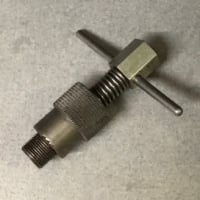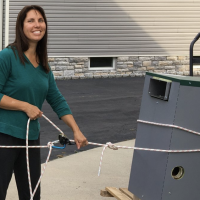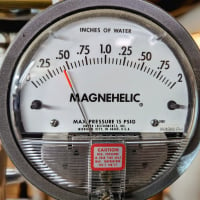Question about swing joints
Comments
-
The piping diagrams supplied by the manufacturers usually specify the straight up and over approach piping as a minimum standard. It does insulate the boiler block from some of the difference of lateral expansion between that and the header piping.
The drop header will provide even more expansion/contraction protection, with the added important bonus of separating out any water which blows up the risers, and directing it into the equalizer, and the wet return. I believe that a welded header can only be used with such a drop header.—NBC1 -
A swing joint is considered to be 2 elbows, a double swing is considered to be 3 elbows.
I used to get into this with underground oil tanks. They always insisted on double swing joints set up so the joints would tighten if the tank settled.
Look up the expansion of steel pipe from a temp rise of 200 degrees. It is very little on a short run. In fact it's 1.55 "/100 feet of pipe. So a 3' riser or header the expansion would be only .0465"
10' of steel pipe=.155" just over 1/8"
What you don't want to do is put stress on the boiler sections. Just visualize the piping connected to the boiler. If the risers can move so the boiler won't be stressed your good1 -
A swing joint -- see @EBEBRATT-Ed 's comment above -- will take up angular misalignment --viewing from the side, the pipes aren't at right angles. It's often required in steam piping, as the "horizontal" pipes aren't actually horizontal -- they have to pitch -- but the vertical pipes are usually set vertical (leaning pipes bother people), and you need a swing joint to do that.
A double swing joint will take up angular misalignment, but it will also allow each pipe to move longitudinally with expansion (or other movements -- like @EBEBRATT-Ed 's oil tanks). There are other ways to do that, though, depending on which pipe or pipes you expect to expand and where they are restrained.Br. Jamie, osb
Building superintendent/caretaker, 7200 sq. ft. historic house museum with dependencies in New England0 -
-
Setting aside the fact that the "pipe" leading to the exterior is at an exaggerated pitch and nothing is to scale, is my mockup of a three-elbow swing joint using some bits of copper I had lying around valid in principle? I just want to understand what is supposed to move (not intending a DIY). The copper threads held by the vise represent the connection point of the fill pipe on the top of a low-profile Roth tank (54H x 51L x 30W). Where the pegboard is would be a wall behind the tank, and the tank is parallel to that wall, and the tank name-plate is on the left side as you face the wall. The tank will have vertical movement of up to 1/4 inch according to the Roth documentation.
0 -
There are no threaded pipes on this mock-up. You need threaded joints to have a swing joint. After those pipes are soldered together, they will not "swing" when the temperature change causes expansion and contraction of the different metals.
This is not the best location to ask this question. You should start your own discussion (Post) and if you want to refer to a previous post, you can do so by copying the address from the ULR at the top of the web page and copy it on your comment like this:
I have a question about this subject and I looked at
And want to know such and such about it…
Adding to an old discussion can be quite confusing it you are looking to solve YOUR problem, especially if you problem is not exactly the same problem.
Edward Young Retired
After you make that expensive repair and you still have the same problem, What will you check next?
0 -
The riser coming out of the vise needs to go up to just short of the hole in the wall for the pipe going outside. You need a little pitch from outside to the tank but not that much. By exagerating the pitch your losing some of the swing.
The pipe (both fill and vent) only need enough pitch so they will not hold oil
1 -
Threaded steel pipes don't actually swing anyway. Within a few weeks/months they are rusted and do not actually swing.
In fact even before rust I doubt they ever swing if they are tightened properly.
Mark your joints with a sharpie and see. The marks will never move. Not in a residential application, anyway.
NJ Steam Homeowner.
Free NJ and remote steam advice: https://heatinghelp.com/find-a-contractor/detail/new-jersey-steam-help/
See my sight glass boiler videos: https://bit.ly/3sZW1el0 -
-
The amount of movement is exceedingly small — as @mattmia2 said, at the very least a dial indicator and rigid pins. That, however, doesn't mean it is zero. It isn't. The point of a swing joint is to allow an expanding (or contracting) pipe to transmit that movement to a joint which can twist slightly but relatively freely. If it can't do that — say it goes to a joint which really is rigid, the forces can be very large. Now if the joint is really rigid — say, for instance, really well welded or brazed, that may not be a problem. Otherwise — say, for instance, soldered, small cracks will form in the joint material and, over time, will get larger (called fatigue cracking — for heating applications it would be low cycle high stress fatigue) and eventually the joint will fail.
Br. Jamie, osb
Building superintendent/caretaker, 7200 sq. ft. historic house museum with dependencies in New England1 -
My beef is i don't see how a threaded joint that relies on the steel deforming can move back and forth and not start leaking.
Even after 100 years.
I think the pipes act like leaf springs and that's the extent of it.
Single pipe 392sqft system with an EG-40 rated for 325sqft and it's silent and balanced at all times.
4 -
It relies on the goop in the valley of the joint but i don't want to start that debate again.
0 -
While the joint may move very small amount as @Jamie Hall said, I agree with @ChrisJ that forces are also distributed along the leg sections as slight deflections based on the “k” factor of the pipes. Regardless, any configuration that allow the force to be exerted other than directly along the boiler longitudinal axis would work. Swing arms are an easily configured solution and typically recommended by mfg so it’s a win win.
0 -
Sometimes the flexibility of the pipe is used to take up expansion movement, as in expansion loops (big U bends separating long sections of straight pipe). It isn't really all that difficult to figure out how long the legs of the U have to be to absorb a given amount of expansion or contraction at a reasonable level of stress in the piping.
How to cope with expansion is an interesting little corner of mechanical or civil engineering…
Br. Jamie, osb
Building superintendent/caretaker, 7200 sq. ft. historic house museum with dependencies in New England2 -
Swing joints are usually in the discussion on oil piping with underground oil tanks.
In residential underground tanks the tank was just set on the dirt and it could settle after the piping was installed.
On commercial with large 10,000 gallon tanks (a common size when I was installing them) the tanks were usually set on a concrete pad with anchor rods with hold down anchors set in the slab.
The slabs were designed (hopefully) to hold the tank down with an empty tank and high ground water. Not an easy task.
All the old specs specified all the piping needed double swing joints (3 elbows) to allow the tank to settle,
Some jobs you don't forget. Gardner Jr High School Gardner, MA I set a 20,000 gallon tank. The tank was delivered during the winter and the engineers would specify primer on the tank at the factory. It would come in on a low bed trailer as a 20,000 is pretty high. The trailer would come with just the driver with a bunch of old tires. He would roll that huge tank off the trailer by himself and land it on the old tires so it couldn't roll away.
We were a sub so our job was to supply the oil burners and the tank for the Mechanical contractor to install. We also were "supposed to" paint the tank after delivery because some paint would get scraped off during unloading.
Try painting a tank in the winter with frozen snow and frozen mud on it😂😂😂😂
The reason I remember this job was not the painting but the day we set the tank in the hole they had 3 huge pumps pumping groundwater out of the hole and an oil truck on site to fill the tank as soon as it was set. Once the tank was set (picture a round tank on a flat slab) the had 6 guys in the hole shoveling concrete into the bottom curve between the tank and slab to make the pad heavier.
I often wondered if it floated!!!!
1 -
@EBEBRATT-Ed mentions up there using swing joints for settling and other movement — that's a more extreme situation, and you really do need them!
He also mentioned kind of in passing (thanks, though, Ed — not everyone realises this): a swing joint — or any joint on threaded piping — can absorb movement only in the plane perpendicular to the joint. So a truly flexible joint, such as is needed for settling or any other kind of movement, must have three joints perpendicular to each other, to provide for movement in all three planes.
Sometimes only two planes are needed — such as at the top of a steam riser to service a not-quite-horizontal runout.
Br. Jamie, osb
Building superintendent/caretaker, 7200 sq. ft. historic house museum with dependencies in New England0 -
And this alleged tiny movement that no one can observe is supposed to do something? I know you have tried to unscrew a fitting before. You must know it doesn't move.
All the old specs specified all the piping needed double swing joints (3 elbows) to allow the tank to settle,
Settling shortly after installation I can buy
NJ Steam Homeowner.
Free NJ and remote steam advice: https://heatinghelp.com/find-a-contractor/detail/new-jersey-steam-help/
See my sight glass boiler videos: https://bit.ly/3sZW1el0 -
If they dug it properly in to untouched soil and compacted any soil underneath they disturbed there would be little settling but take a look in most neighborhoods where they trenched for the utilities and didn't compact it, it settled over decades.
A threaded joint moves with 2 8 ft levers on both sides of it.
0 -
If you look at the complete manufacturer's installation manuals, you will always find swing joint or at least arms on anything over 1 riser. Peerless specifically requires threaded joints on thier headers. Weil used to allow all welded in thier manual, but now require at least 2 threaded joints on the boiler riser. What you will see is that another swing joint is required where the header drip ties into the return on all boilers….. so single riser headers without an off set will still have a second swing joint where it connects to the boiler return.
To learn more about this professional, click here to visit their ad in Find A Contractor.0 -
I know the OP used a photo of copper but I believe that was just for illustration. I thought we were talking about threaded joints. Sorry my friend but when I have applied a 24" wrench with a 4' cheater to them they did not have any joint movement until they busted loose. There was plenty of pipe deflection though, like Chris mentioned.
I do look forward to seeing someone's results with the calipers and alignment pins!
NJ Steam Homeowner.
Free NJ and remote steam advice: https://heatinghelp.com/find-a-contractor/detail/new-jersey-steam-help/
See my sight glass boiler videos: https://bit.ly/3sZW1el0 -
your probably thinking steam. threaded pipe other than steam can move.
Besides we have seen boilers that failed when they use two or three risers out of the boiler into the bottom of a header weather welded or screwed and the header is a straight line. We are told to come up with the risers and use swing joints into a header horizontally.
Something has to move with expansion and contraction or all the boilers would fail
1 -
I always thought the swing joints were intended to allow pipe movement resulting from thermal expansion by enabling the addition of torsional deflection in the risers thus minimizing the bending stress transmitted down to the boiler sections. Like @ethicalpaul I never envisioned the threaded joint "releasing". I just thought welded joints were bad because they would be more likely to fail being a stress concentrator at a high stress location. Little do I know though.
1 -
I would think the threaded pipe joints settle after the insulation . The majority movement of the pipework would be after the first heat cycle or fill up . When all of the pipe work heats up at the same time it will expand outward together . I don't see a twist ..
There was an error rendering this rich post.
0 -
The situation that @EBEBRATT-Ed mentions— straight header over two or three risers — is really lethal to boilers. But… there are other ways!
The basic principle here is that every pipe (or, for that matter pretty much anything) will change length with changes in temperature. It's not a whole lot: the thermal expansion of steel is about .0001 times the length times the temperature change. Copper is almost 20 times as much. The forces, however, are huge — thousands of pounds. A lot more than a 4 foot cheater on a pipe wrench can manage!
Although the distance the pipe or what have you will try to move is small — so is a crack. And crack something will, if it is a weak point which concentrates the force. And once a crack has formed, it will get bigger over time (for what we are doing this is low cycle (that is infrequent stressing) high stress (very high forces) fatigue.
This sort of thing is a real problem in civil engineering, structural engineering, and aerospace engineering — and should be, but often isn't, in automotive engineering. Also power and chemical work.
Br. Jamie, osb
Building superintendent/caretaker, 7200 sq. ft. historic house museum with dependencies in New England2 -
Categories
- All Categories
- 87.3K THE MAIN WALL
- 3.2K A-C, Heat Pumps & Refrigeration
- 61 Biomass
- 429 Carbon Monoxide Awareness
- 120 Chimneys & Flues
- 2.1K Domestic Hot Water
- 5.8K Gas Heating
- 114 Geothermal
- 166 Indoor-Air Quality
- 3.7K Oil Heating
- 77 Pipe Deterioration
- 1K Plumbing
- 6.5K Radiant Heating
- 395 Solar
- 15.7K Strictly Steam
- 3.4K Thermostats and Controls
- 56 Water Quality
- 51 Industry Classes
- 50 Job Opportunities
- 18 Recall Announcements











